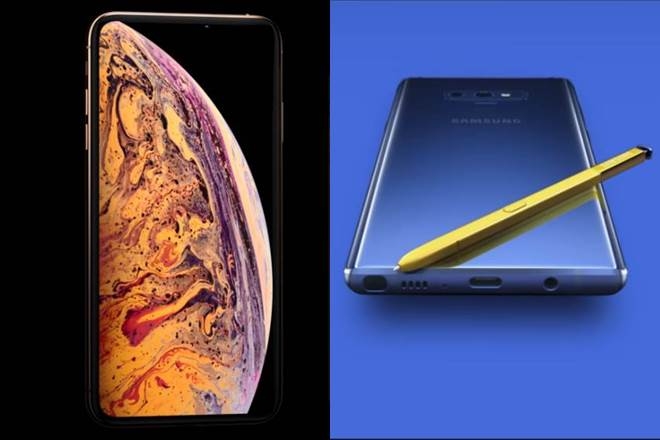Apple Inc. introduced the world to its largest-ever smartphone on Wednesday, the iPhone Xs Max. With a 6.5-inch screen, it dwarfs the 3.5-inch display on the original iPhone that Steve Jobs unveiled to the world in 2007. It’s also one of the biggest and most costly phones to hit the market, with prices starting at $1,099. Onlookers will be forgiven for seeing the Max as a response to the popular Galaxy Note series made by Samsung Electronics Co. The latest in that line, the Galaxy Note 9, was released in August and has a 6.4-inch screen.
iPhone XS Max Vs Samsung’s Galaxy Note: Size and Weight
Samsung’s Note 9 is the lighter of the two phones, weighing 201 grams compared to Apple’s 208 grams. But the iPhone is about 13 percent thinner. A big contributor to this difference is the inclusion of Samsung’s stylus, or S Pen, which is stored within the Note’s chassis.
The accessory highlights one of the key differences between the two products, and for some consumers is more important than a fraction of an inch of screen size or depth. The S Pen can be used for handwriting, annotation, and precise navigation around the Note’s interface. In Apple’s world, this is a luxury afforded only to iPad users for the time being.
iPhone XS Max Vs Samsung’s Galaxy Note Screen and Design
Another important difference concerns “the notch.” At the top of the iPhone’s screen is a small cut-out that houses the front-facing camera and other sensors. Some Android-powered phones have followed this trend but the Note 9 hasn’t. Instead, Samsung’s screen is an uninterrupted rectangle.
iPhone XS Max Vs Samsung’s Galaxy Note: Features and Security
Apple and Samsung’s models both include two camera lenses to the rear — one wide-angle, one telephoto — which capture pictures at a resolution of 12 megapixels. The setup lets users take sharp pictures from greater distances, or create a blurred background effect, known as bokeh, which historically was a quality confined to professional cameras. Both companies will argue their respective software and image processing technologies will produce better results, but to the majority of users the differences will be too little to sway a purchase alone.
Apple Inc. introduced the world to its largest-ever smartphone on Wednesday, the iPhone Xs Max. With a 6.5-inch screen, it dwarfs the 3.5-inch display on the original iPhone that Steve Jobs unveiled to the world in 2007. It’s also one of the biggest and most costly phones to hit the market, with prices starting at $1,099. Onlookers will be forgiven for seeing the Max as a response to the popular Galaxy Note series made by Samsung Electronics Co. The latest in that line, the Galaxy Note 9, was released in August and has a 6.4-inch screen.
iPhone XS Max Vs Samsung’s Galaxy Note: Size and Weight
Samsung’s Note 9 is the lighter of the two phones, weighing 201 grams compared to Apple’s 208 grams. But the iPhone is about 13 percent thinner. A big contributor to this difference is the inclusion of Samsung’s stylus, or S Pen, which is stored within the Note’s chassis.
The accessory highlights one of the key differences between the two products, and for some consumers is more important than a fraction of an inch of screen size or depth. The S Pen can be used for handwriting, annotation, and precise navigation around the Note’s interface. In Apple’s world, this is a luxury afforded only to iPad users for the time being.
iPhone XS Max Vs Samsung’s Galaxy Note Screen and Design
Another important difference concerns “the notch.” At the top of the iPhone’s screen is a small cut-out that houses the front-facing camera and other sensors. Some Android-powered phones have followed this trend but the Note 9 hasn’t. Instead, Samsung’s screen is an uninterrupted rectangle.
iPhone XS Max Vs Samsung’s Galaxy Note: Features and Security
Apple and Samsung’s models both include two camera lenses to the rear — one wide-angle, one telephoto — which capture pictures at a resolution of 12 megapixels. The setup lets users take sharp pictures from greater distances, or create a blurred background effect, known as bokeh, which historically was a quality confined to professional cameras. Both companies will argue their respective software and image processing technologies will produce better results, but to the majority of users the differences will be too little to sway a purchase alone.










174.jpeg)
113.jpeg)
148.jpeg)
79.jpeg)
69.jpeg)
19.jpeg)
5.jpeg)







